11 Things to do in Bar, Montenegro by Historian Nikolai Stepanov
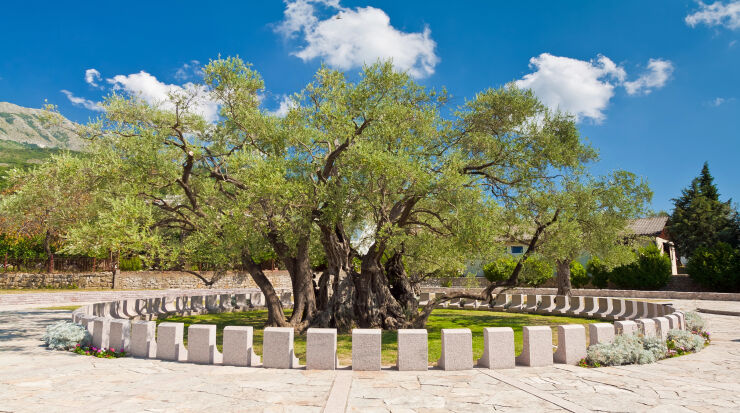
This article is about Bar, a city in Montenegro that is divided into Old and New parts. Sightseeing advice on what you can do there by Historian Nikolai Stepanov.
Contents
Old Bar: City History and Sights
1. Old Bar Fortress
2. The Old Olive Tree
3. Selimiye Mosque
4. Aqueduct
5. Clock Tower
New Bar: History of The City and Sights and other things to do in Bar
6. Seaport
7. City Embankment
8. King Nikola's Palace
9. Church of St. John-Vladimir
10. Church of St. Peter the Apostle
11. Zero Kilometer Sign
Beaches of Bara
The Resort Villages of Sutomore, Chan and Shushan
Good Water and Comfort
How to Get to Bar
Sightseeing Map of Bar
In case you were wondering, "Is Bar, Montenegro worth visiting?", here are some of the most interesting things to see in as little as 3-4 hours. First of all, head to Old Bar where you can find plenty of things to do and see that unravel the essence of this city:
- Start your journey from the Old Olive Tree in Mirovica, which is almost 2500 years old. Scientists say that groundwater is eroding its roots and the tree might die, so take the opportunity to acquaint yourself with this legendary tree under which Roman legionaries once rested.
- If you walk from the Olive Tree into the fortress, you will enter the trading street "Barska Charshiya." You can stop for a portion of Turkish coffee, which is always served with the most delicate Turkish delight. Right there, on the approaches to the fortress, you can also have lunch in one of the numerous cafes.
- Another thing to do in here is to enter the Old Town fortress through the main gate, head to the northern part of the fortress, towards the legendary aqueduct, a true marvel of Turkish engineering. From the aqueduct, it’s a short walk to the "Tatarovica" citadel, offering breathtaking views of the surrounding areas.
If you have more time to spare, follow the suggestions below and try to visit all the main attractions of this Montenegrin city. The main attractions are selected and ranked based on their historical value and their frequency of appearance in tourists' sights. There are objects in any city that may not have a long history but catch the eyes of tourists so often that they are worth mentioning to satisfy the curiosity of any visitor and are worth to be seen here.
Old Bar: History of the City and Attractions
The history of this city in Montenegro is connected with the Ottoman Empire, and like the neighboring Albanian-populated Ulcinj, it became part of Montenegro only at the end of the 19th century (1878). Therefore, about a third of the city's population today consists of Slavic Muslims, who mostly live in areas adjacent to the historic core of the city. They live near the fortress now called "Old Bar."
Located several kilometers from the sea and surrounded by fortress walls, the old city was called Antibari until the 19th century, sometimes Antivari, sometimes Antibarium. Across the Adriatic Sea lies the Italian town of Bari, and in Latin, "anti" means the opposite. Interestingly, the toponym Antivari has been preserved in the modern Albanian language, and today Albanians call this city Tivar.
The name Old Bar appeared in the early 20th century after the founding of New Bar, i.e., "Pristan" (port), and later a cargo port with residential micro-districts on the coast. The fortress of Antibari was first mentioned by the Byzantines in the 10th century, and the fortress walls that you can see today were erected by the Venetians in the 15th century. The Turks, who took over the fortress in 1571, rebuilt part of the walls and internal structures, and in 1878 the fortress passed into the hands of Montenegro.
1. Fortress “Old Bar”
The area of the old part of the city is located 4 kilometers from the coast and is significantly older than its younger industrial counterpart.
Fortress “Old Bar”, Montenegro
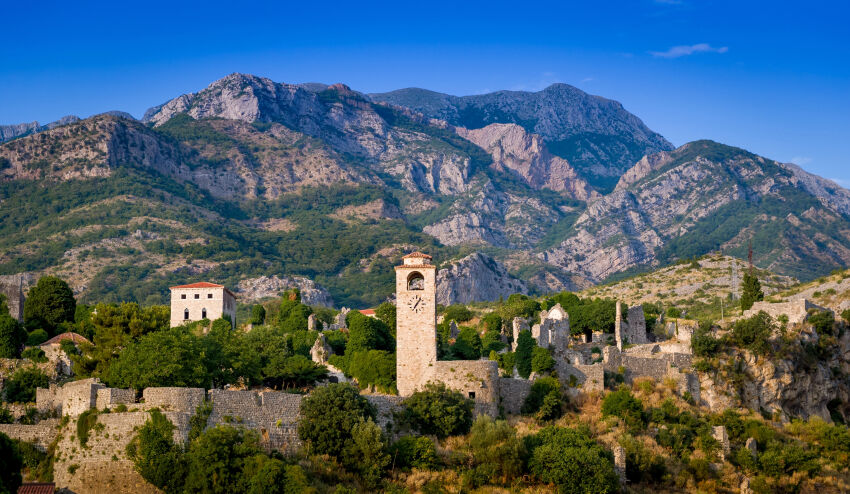
Now inside the fortress are the so-called "Montenegrin Pompeii," i.e., the ruins of Antibari. There were several reasons for this ruination: from the explosion of an ammunition depot at the end of the 19th century to the earthquake of 1979. One thing can be said for certain, you won't be able to stroll through the streets of the Old Town like you can in Budva and Kotor. There are hardly any intact buildings left inside the fortress; paths are laid out between fragments of walls and foundations. So, wear sturdy shoes if you decide to visit this place.
The mysterious explosion of 1881 destroyed almost all the buildings within the fortress walls. By that time, the Turkish fortress had been captured by the Montenegrins after a prolonged siege. It's still a matter of speculation who benefited from this explosion. The authorities are now attempting to restore some of the buildings inside the fortress walls. Restorations completed so far include: the customs building in Renaissance style, the Gothic palace of the Catholic bishop (now housing a museum), the clock tower "Sahat Kula," the hammam, the aqueduct, and the powder magazine — “barutana.”
2. The Old Olive Tree
This legendary tree provided shade for Roman legionnaires to rest under.
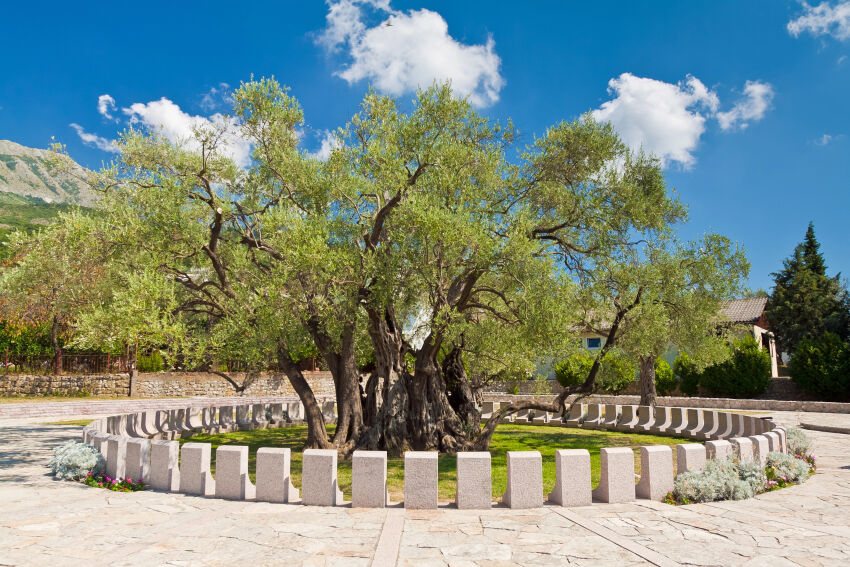
The olive tree will undoubtedly catch your attention. Scientists from the Faculty of Forestry at the State University of Turkey estimate its age to be between 2200 and 2500 years. Since 1957, it has been declared a national treasure of the country.
In the area of Bar and Ulcinj, there are hundreds of thousands of olive trees. Time twists their trunks, creating holes and cracks, and eventually, the olive tree splits into several independent trunks. This is what happened to Montenegro's main olive tree. Currently, more than 10 trunks are intertwined at one spot, forming a perimeter of over 10 meters, and it can accommodate 4 adults inside.
It is said that this "Olive Tree in Mirovica" is one of the oldest in all of Europe. The place where it grows is called Mirovica because the tree had a special peaceful energy, and reconciliation rituals were conducted in front of the ancient olive tree for many years. Nowadays, it is a popular spot for newlyweds. You too will likely feel the special energy of tranquility under this olive tree's shade.
The tree is surrounded by a fence and entry is paid, but trust me, your money will be well spent. Recently, groundwater has been eroding the olive tree's roots, and scientists are very concerned about how it will fare into its third millennium. Serious drainage work is needed to divert groundwater away from the roots of the old olive tree in Mirovica.
Nevertheless, the olive tree still bears fruit: about 100 kg of olives per year.
3. Selimiye Mosque
This is not just a mosque, but also a true Islamic cultural center.
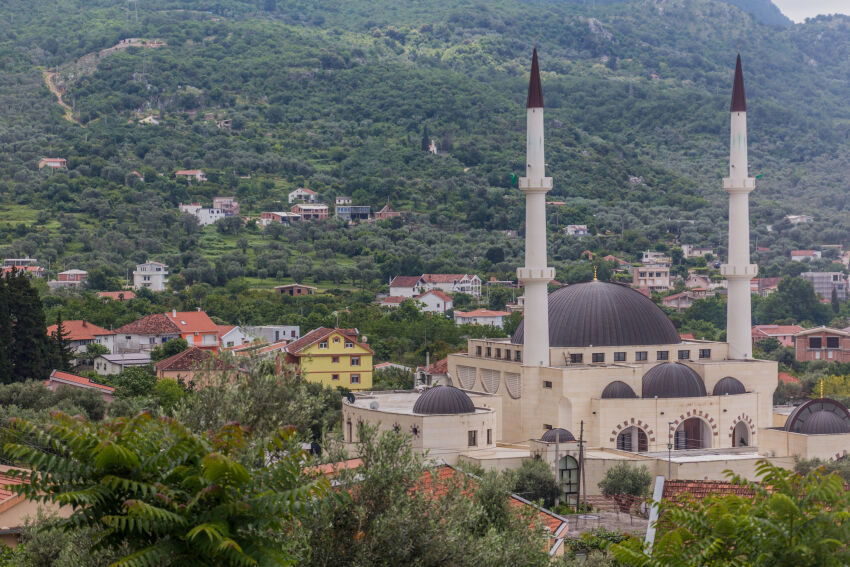
The Selimiye Mosque is one of the largest mosques not only in Montenegro but also in the entire former Yugoslavia. It can accommodate 2,000 worshippers at once.
The mosque is named after Sultan Selim I, the father of Sultan Suleiman the Magnificent, the conqueror of the Balkans. Until the late 19th century, a mosque with the same name was located inside the fortress of the Old Town, but now only its foundation remains.
The idea of building a spiritual successor to the old city mosque, Selimiye, emerged in the 19th century after the Old City was destroyed by a terrible explosion. However, the first stone in the foundation of the mosque was laid only on July 28, 2002.
The mosque was built over 12 years according to the design by architects Selim Resulbegovic and Fuad Mavric from Ulcinj. In addition to the mosque, the complex includes an Islamic cultural center. The total area of the structure is 4 square kilometers.
The spiritual center complex based on the Selimiye Mosque consists of two symmetrical wings. One part houses administrative offices, classrooms, a kindergarten, a library, and a reading room, while the other part contains a restaurant and a small hotel for Muslims coming from all over the world. Most guests come from Turkey, likely because the Turkish government provided half of the funds for the construction of this mosque.
4. Aqueduct
The Aqueduct is a marvel of engineering that has survived to bring water from a spring at the foot of the Rumija mountain range.
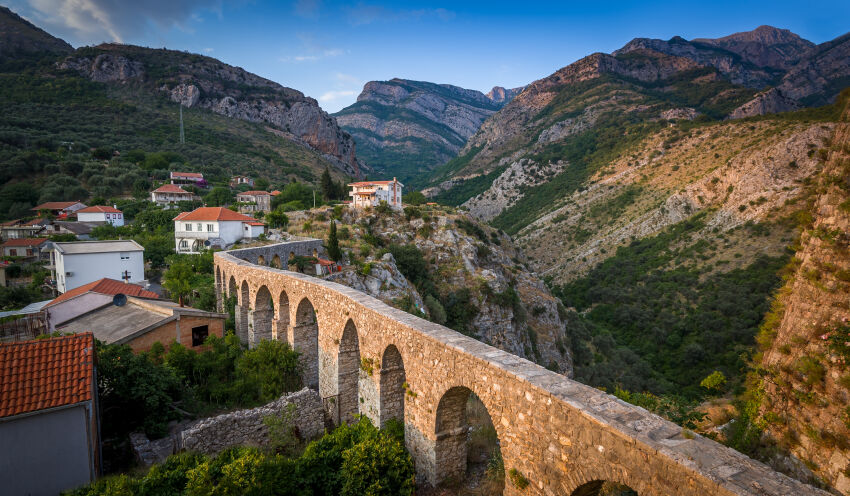
The aqueduct was built at the turn of the 16th-17th century by the Turkish governor Zeynel Bey Haveric. He organized the collection of funds (wakf) for the construction of a three-kilometer aqueduct from the Mukoval ridge to the fortress. Zeynel Bey himself donated a plantation of 1,000 olive trees for the construction. The length of Bar's water supply system was several kilometers, with the aqueduct being the most complex part. It has 17 supporting pillars and as many arches.
In the 19th century, Zeynel Bey's creation underwent reconstruction, and instead of stone gutters, metal pipes were installed for the water flow. By detonating 225 kg of explosives under the aqueduct in early 1878, the Montenegrins stopped the water supply to the besieged fortress, causing the garrison to surrender.
The remnants of the aqueduct were significantly damaged during the 1979 earthquake, but Yugoslav engineers restored it in full accordance with the original design, so the aqueduct is still capable of supplying water to the fortress. Only three such structures have survived in the former Yugoslavia, as they are very fragile. Today, aqueducts can still be seen in Skopje (Macedonia) and Split (Croatia).
You can see this engineering marvel from the northern part of the fortress wall. Signs inside the fortress will guide you to the embrasure through which the famous Aqueduct is clearly visible.
5. Clock Tower
The Sahat Kula Clock Tower is a true symbol of the city.
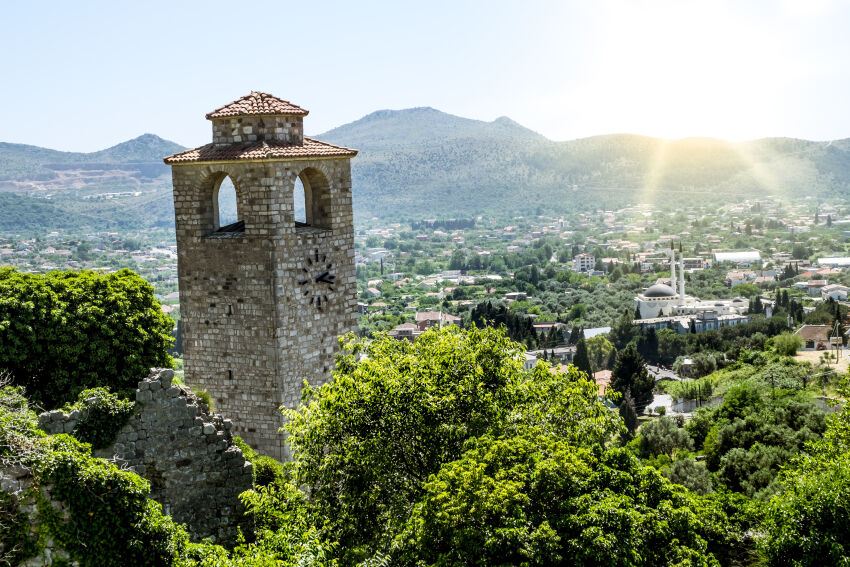
The exact time of the clock tower's construction is unknown. Some scholars suggest its first indirect mentions date back to the Venetian period (15th century), while others attribute its construction to the Middle Ages. However, it was primarily a watchtower covering the southwestern gates of the fortress.
One thing is certain: it acquired its modern appearance and clock mechanism thanks to the wakf (investment fund) of Yahi-aga Ibrahim Osmanov. The tower was reconstructed by him in 1753, when a mechanism was installed, and the architecture of the upper part was significantly altered. The fate of such a tall and elegant structure turned out to be unfortunate.
The tower suffered significant damage from the siege and prolonged artillery bombardment by the Montenegrins in 1877, the internal explosion of the fortress in 1881, and the 1979 earthquake. Finally, Yugoslav engineers restored its original "Turkish" appearance in 1984/86, and Czechoslovak craftsmen made new chain-driven clocks for the tower. In 2023, the clock tower received another grant of 100,000 euros, and the authorities not only reinforced the tower but also restarted the clock, which had been stopped for 12 years. Now, it once again shows the correct time to the residents and numerous tourists visiting this most "eastern" city of Montenegro.
The Sahat Kula is located in the southern part of the fortress and is easily recognizable from the parking lot.
New Bar: History of The City, Sights and other attractions of the city
For a long time, the Montenegrin port city of Bar was not considered a tourist or beach destination. By Montenegrin standards, it is a large city, with a municipal population of over 45,000 people.
The construction of the port terminal, passenger pier and the new seaside town began in the early 20th century when Montenegro was still an independent kingdom. The modern appearance of the new seaside town, located 4 kilometers from the fortress, was shaped during the times of Socialist Yugoslavia, following the devastating earthquake of 1979. The epicenter of this earthquake was right here, in the depths of the Adriatic, just 15 km from the coast.
The port, fortress, hotels, and homes were all renovated after this severe catastrophe. A striking example of the city's renewal following the disaster is the "Izbor" shopping center. It stands out in the city center with its brutalist modernist architecture and was constructed immediately after the earthquake, from 1980 to 1984.
The modern city retains vivid features of that socialist Yugoslavia. You will find little of the resort "spirit" in its orderly streets with wide parking lots. The port remained the city's main focus until recently, rather than the beaches. There is a passenger terminal building in the city, but it is currently not in use for its intended purpose, as there are no maritime passenger lines connecting this city with other cities in the country and the world.
6. Seaport
The port is the main cargo and oil terminal not only for Montenegro, but also for Serbia.
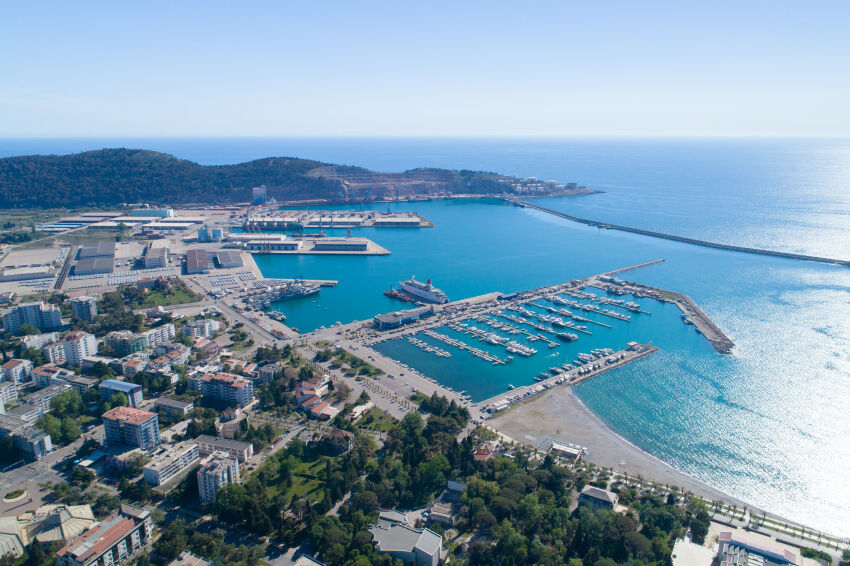
The history of the New City has an official starting date in 1908 when several Montenegrin settlements in the "Pristan" area were granted the status of Varosha, meaning settlement. As a result of the Berlin Congress of 1878, Montenegro gained its long-awaited access to the sea. A passenger pier was built by the sea in the Topolica lagoon area, and small piers for loading and unloading cargo were constructed closer to Volujica. The aforementioned 1908 is also significant because it marks the launch of the narrow-gauge railway from Pristan to Virpazar.
This railway was built by an Italian-Montenegrin syndicate, and it was then that the settlement and port complex by the sea began to be called New Bar. Montenegro's economy started to develop rapidly, the Bar-Virpazar railway was modernized, and the port area and its warehouses expanded. In 1944, the old port structures were blown up by retreating German occupiers.
The socialist authorities built a new, technologically advanced port with grain and fuel terminals. The launch of the modern Bar-Belgrade railway in 1974 elevated the city's port to the level of an international transport hub, making it the main port not only for Montenegro but also for Serbia.
Due to the constant expansion of the port complex, all old settlements in the Volujica Peninsula and the former pier area were relocated in 1976. After the 1979 earthquake, many buildings in the city were rebuilt. Today, the port area includes the Montenegrin Navy's naval base and a passenger terminal, which you can easily see and visit if you wish.
7. City Embankment
The city embankment proudly stretches out with remarkable length, generous width, and lush greenery. A location really worth visiting, teeming with entertainment, where the scent of the sea mingles with the sweet fragrance of blooming trees.
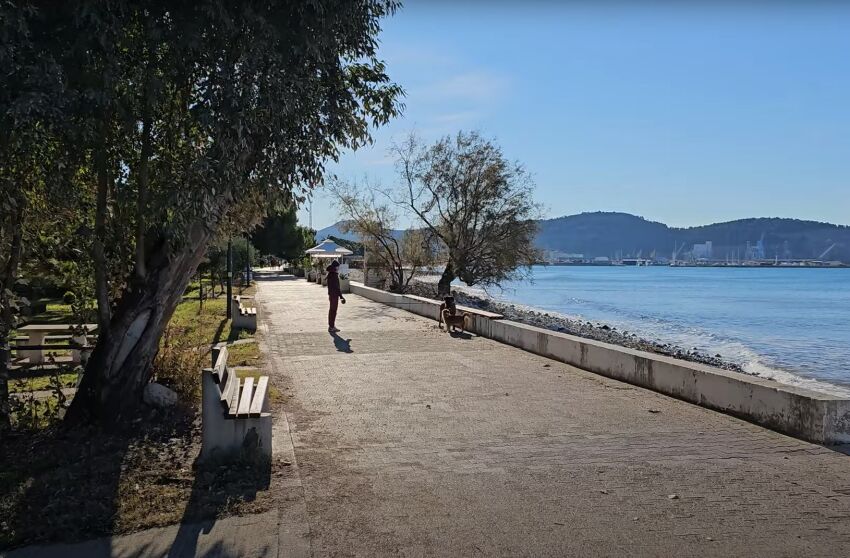
The embankment extends 2.5 kilometers from the city port and passenger terminal all the way to the village of Shushan. The walking area is surrounded by numerous trees, and at its very beginning, near the city yacht parking, you'll find a palm tree alley.
The city has a wide bankment that crosses the Željeznica River along its path. The bridge over this river attracts many children and visitors, as they can feed the ducks living in the river near the bridge.
From the city embankment, you can enter the courtyard of King Nikola's Palace, where a small botanical garden with huge pines, palms, and eucalyptus trees awaits you. A few things you can do through the embankment is go to cafes, pizzerias, and pastry shops, all that being right throughout the whole embankment area.
The most charming pastry shop in the city is Café Martina, located right on the seashore. When the sea is restless, the salty sprays reach the feet of visitors, blending the invigorating scent of the ocean with the sweet aroma of desserts and ice cream.
At the very beginning of the alley, you will see the "Zero Kilometer" monument, a portal connecting you to many interesting places on Earth, and a monument to the chronicler Pop Dukljanin. It is through this chronicler's works that the medieval history of this city and its surroundings became known.
8. King Nikola's Palace
Though the palace is formally known as King Nikola's, it was actually built by his father. Located by the sea and clearly visible from the embankment, King Nikola's Montenegrin palace now welcomes guests to its small ethnographic and historical museum.
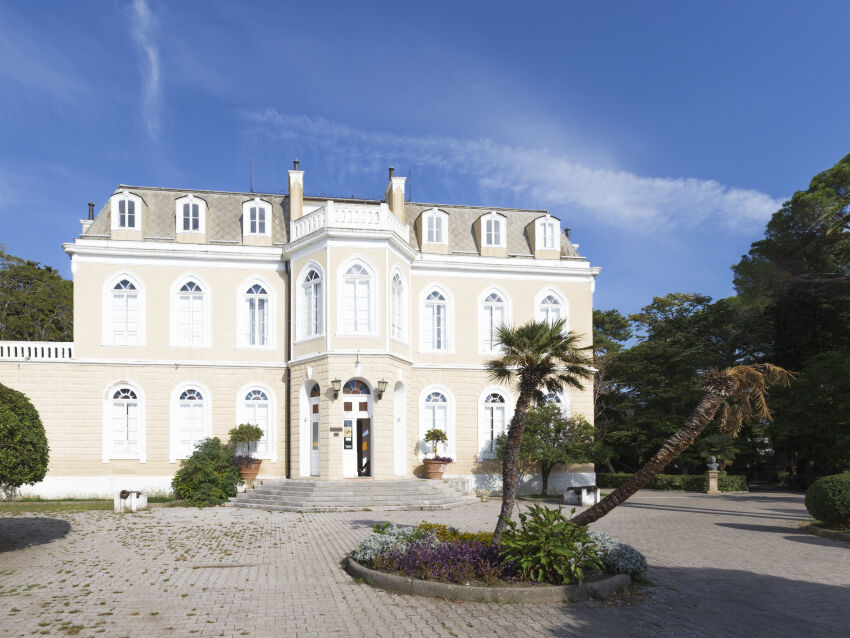
This museum evokes the period from the late 19th century to the First World War, when the mountainous Kingdom of Montenegro gained a crucial maritime outlet, vital for its economy. Important local figures and visitors needed a place to rest before setting off on a voyage or traveling to Montenegro's capital, Cetinje. Thus, a villa for VIP guests was constructed, initially called the Prince's Palace and, from 1910, the Palace of King Nikola I. Interestingly, during King Nikola's reign, this luxurious edifice was referred to as the "Palace of Crown Prince Danilo" or simply "Villa Topolica."
In the late 19th century, Prince Nikola I of Montenegro received a yacht named Sivil from the Ottoman Sultan, which was harbored at the Topolica pier, completing the ensemble of royal luxury. The seaside palace played a significant role in 1910 when the Principality of Montenegro was proclaimed a kingdom, and royals from a dozen countries attended Nikola's coronation. Before the arduous journey to Cetinje—first by train, then by car—many of these dignitaries spent the night in this coastal villa.
Today, King Nikola's palace functions as a regional museum with an ethnographic exhibition. Some rooms are dedicated to temporary exhibits. In the villa's courtyard, pines, palms, and eucalyptus trees planted before the First World War still grow, creating a serene spot that is sure to impress. While there is an entrance fee for the museum, you can stroll around the palace grounds for free.
9. Church of St. John Vladimir
The church can accommodate 1,200 people at once.
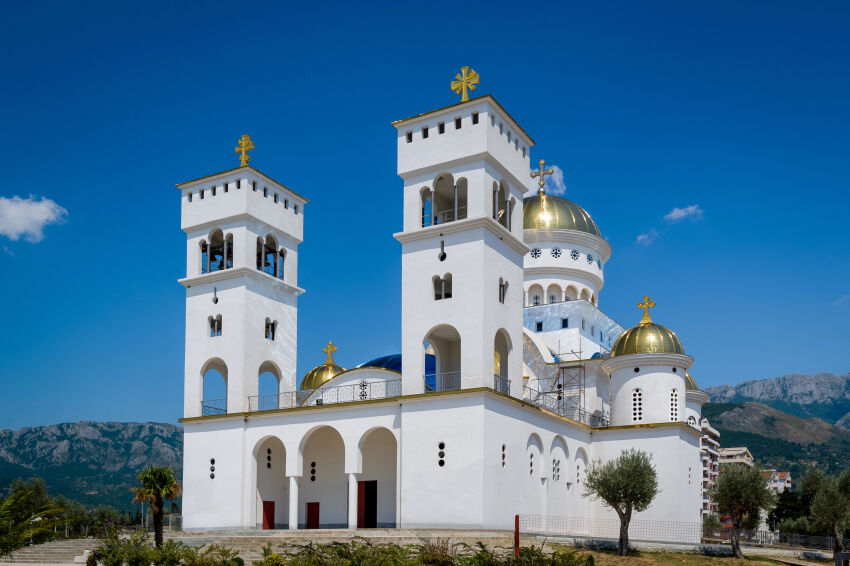
Churches began to be restored in the late 19th century after the departure of the Ottoman Turks from these lands. However, the cathedral church was only built in the 21st century. The Orthodox Church of St. John Vladimir was consecrated on September 25, 2016, marking the millennium of the death of St. John Vladimir to whom it is dedicated. Construction took ten years. The church is 44.5 meters tall, making it highly visible even from the seaside. This immense church was designed by architect Predrag Ristić, who also created the project for the Church of the Resurrection of Christ in Podgorica, the country's main church.
The design of St. John Vladimir's church is based on the outline of the famous triconch, a 5th-century Christian church whose foundations were discovered and are now preserved outdoors. As befits a cathedral of this magnitude, everything in the main Orthodox church is imbued with symbolism and continuity. Ethnic Montenegrins from around the world, from Los Angeles to St. Petersburg, donated the church's external crosses, iconostasis, and the bishop's throne. A special prayer written on goatskin was placed in the foundation of the church.
The frescoes inside the Church of St. John Vladimir cover an area of 4.5 square kilometers. The church was painted in 1.5 years by the renowned fresco painter Anastasije Radović and his assistants.
Outside the church, you can see a replica of the cherished chapel of Montenegrin Bishop Peter II Njegoš. The chapel was destroyed during the construction of the mausoleum on Mount Lovćen in 1974. Since then, the Orthodox Church has considered the summit of Mount Lovćen desecrated and demands the return of Njegoš's chapel to its original site. Until that happens, the chapel's replica is kept here, at the base of the city's main Orthodox church.
10. Church of Saint Peter the Apostle
The Catholic church is painted in a bright terracotta color, which is quite rare.
The Cathedral of Saint Peter in Topolica was consecrated in 2017. The construction of this Catholic church cost 3.5 million euros and took over ten years to complete. It is the second Catholic cathedral in Montenegro.
The country has long had a division within the Catholic diocese: one part leans towards the Catholics of Croatia and Dubrovnik, with its main church, Saint Tryphon, located in Kotor; the other part, the archdiocese in the coastal city, maintains close ties with Albanian and Serbian Catholics. The archdiocese has 11,000 Catholics, while the Kotor Catholic diocese has only 8,500.
When visiting the Catholic Church of Saint Peter, you might notice that its altar faces west, unlike the city’s triconch, which inspired the architectural design and, like all Orthodox churches, has its altar facing east.
Inside the Cathedral of Saint Peter, you will find beautiful stained glass windows. One of these windows is dedicated to Mother Teresa, the Catholic nun and Nobel Peace Prize laureate.
The Church of Saint Peter is 36 meters tall, with a hall height of 3.5 meters. The main hall of the church covers an area of 2,700 square meters. The exterior of Saint Peter's Church impresses visitors with its unique and vibrant color. Such a historical place is worth visiting to feel its grandeur and exquisite beauty.
11. The Zero Kilometer Sign
An extraordinary sculpture, puzzling in its structure. It's a true enigma how this sign can withstand wind gusts of 150 meters per second.

At the intersection opposite the passenger terminal of the port stands a sign-monument dedicated to journeys. The creator of this unusual monument, Peter Tsarevich, describes his style as "Grand Manner" and claims to have drawn inspiration from the avant-garde sculptors of the late 19th century. The "Zero Kilometer" sculpture, executed in the style of architectural-urbanistic art, was installed in 2015. It is oriented with its base towards the North and South Poles of the Earth. This small sculptural object, in the author's opinion, is imbued with immense meaning.
Firstly, it is equidistant from the beginning of the embankment, the cargo port, the passenger pier, and the central square.
Secondly, every detail of this sculpture carries symbolic significance. The sculpture is shaped like a wing, and each of its segments is rotated by 6 degrees. On its way to the base, the fragments of this stele describe a circle, turning a full 360 degrees. In this way, the artist has embodied the concept of the world's cyclicity and harmonious continuity even in such an urbanized setting.
Thirdly, the places and cities indicated on the plaques remind passersby of the cultural diversity of this world. They remind potential travelers of the many places worth visiting. Through the 6-degree rotation of each plaque, the directions of the indicated cities and locations around the world can be easily determined.
The "Zero Kilometer" sculpture, depending on the internal world of each observer, serves as a symbolic link, a transmitter, a connector, a trigger, urging the viewer towards this journey.
The Beaches of Bar
The town boasts a well-organized layout with straight streets, parking lots, a wide embankment, supermarkets and a large market. Over the past decade, vacationers and settlers from the former Soviet republics have taken a particular liking to this town. Their style of leisure differs from the local norm. They enjoy strolling leisurely along the sea year-round, pushing strollers with children, riding bicycles or scooters. The long 2-kilometer embankment, beautifully adorned with numerous palm trees, accommodates all of these activities. The cafes and restaurants here are cheaper than, for instance, in Budva.
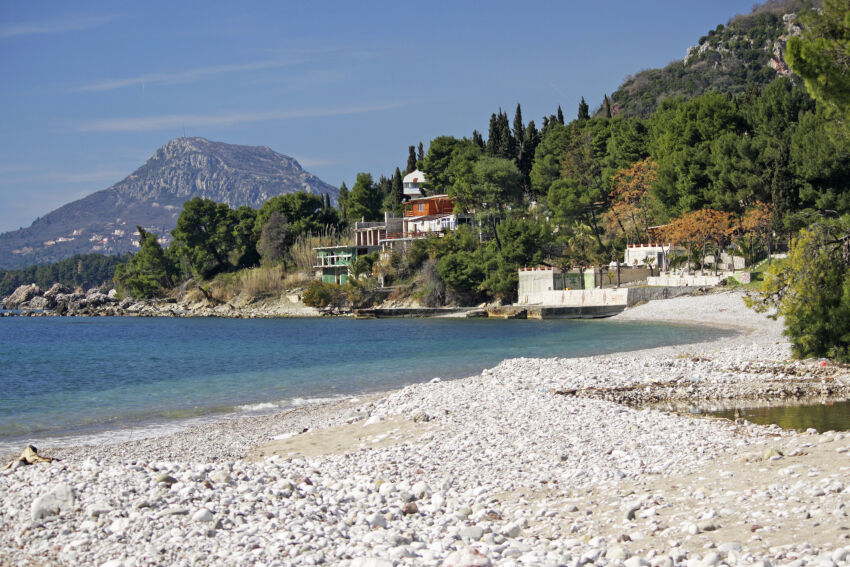
Only the coarse pebbles of the local beaches make entering the sea and swimming somewhat challenging and uncomfortable. Lying on the stones with just a towel, without rented sun loungers, is likely a challenge only yogis can handle; this is the primary drawback of the beaches in this region.
They say that in the past, an oily film used to appear on the urban coastline and the water's surface around the rocky beaches, likely from ships anchored or docked in the port. This issue has now been resolved and on the beaches adjacent to the port you can see more and more vacationers, primarily Russian-speaking ones.
Resort Villages of Sutomore, Chan and Shushan
For tourists from the former Yugoslav republics, who have always been the majority in the coastal city region, the neighboring seaside villages of Shushan, Sutomore and Chan are considered more "resort-like" than the town itself. These resorts are connected to other Montenegrin towns by a narrow strip of coastal land and the same Adriatic (Jadranska) highway.
The railway station in Sutomore has always been convenient for Serbian citizens arriving on the "Belgrade–Bar" resort train. During the summer, there are two trains on this route, a daytime and a nighttime train, but the nighttime train is an all time favorite. Spend the night in a compartment with cheerful residents of the former Yugoslavia, share a drink of grape or plum rakija with fellow travelers, take a nap and in the morning arrive in Sutomore. Breathe in the salty sea air, look around, rent a room from a kind old lady with a shower and toilet in the yard, drop off your things and head to the sea with a pack of cigarettes in hand. That's the Serbian way of vacationing on the Adriatic.
Foreign tourists visit these places less frequently; they have higher demands for comfort. They need infrastructure, parking lots, air conditioning, regular trash collection, new enjoyable homes without mold, proximity to the sea and comfortable paths to the beach. Sutomore, Chan and Shushan often can't boast these amenities. These villages are more for the not-so-wealthy romantics, those who love to stroll leisurely to the sea through green, hilly lanes and hide under the overhanging branches of kiwi trees from oncoming cars driven by half-naked teenagers.
To be fair, the village of Sutomore does have a flatter part, located below the railway and the Adriatic highway, on the "first line." This part of Sutomore is more leveled. However, the density of vacationers and buildings there is so high that the hot July and August days feel even more oppressive than in the "concrete" Budva.
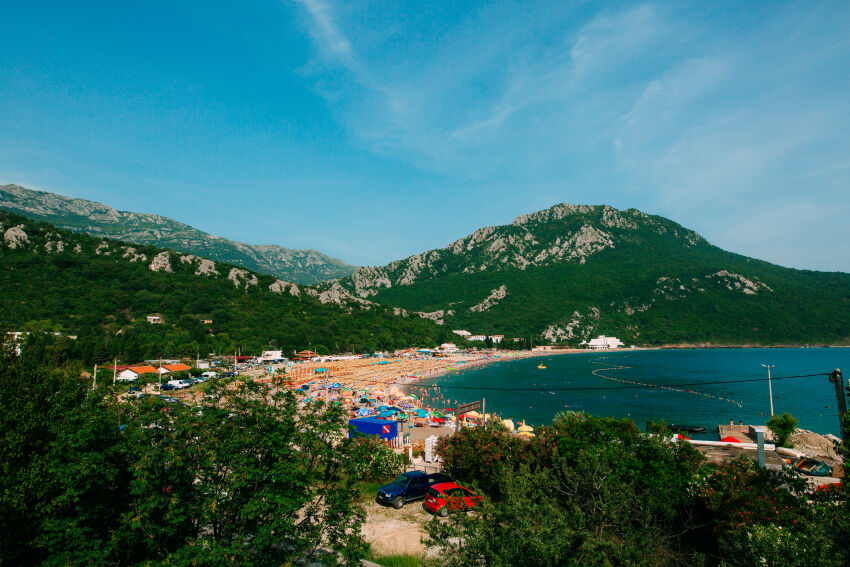
The Sutomore promenade was recently renovated and expanded. Sutomore and Chan have beautiful beaches, but they are also more adapted for "Yugoslav" vacationers, who love to lie on the beach packed closely together, shoulder to shoulder, with an unextinguished cigarette in their mouth or hand, while loud Balkan music from beach cafes and the aroma of grilled meat fills the air.
Good Water and Comfort
The Adriatic Highway through Bar continues its journey towards the predominantly Albanian-populated Montenegrin town of Ulcinj. Along this path lie two large resort villages also belonging to the municipality. We're talking about the towns of Good Water and Comfort. Unlike Sutomore and Chan, these are relatively new settlements. Thanks to their convenient terrain and beautiful panoramas, they are now actively being populated by foreigners, including Europeans.
Comfort (Utjeha) Beach has repeatedly been awarded the prestigious "Blue Flag" and the villages themselves are relatively new, multicultural, and the surrounding areas continue to be actively developed. For instance, there have been recent reports of a significant German diaspora in Good Water (Dobra Voda).
Their main downside is their considerable distance from airports and other parts of the country. But if you're looking for comfortable modern housing and beautiful sea views, then consider the rapidly developing Good Water(Dobra Voda) or Comfort (Utjeha). There are no schools, kindergartens or markets there, and it can be dull and windy in winter. They are purely resort villages, but there is enough space on the beach for both swimming and panoramic views from the window.
How to Get to Bar
This is a city with excellent logistics. In 2005, the 4-kilometer-long Sozina Tunnel was constructed under the Dinaric Mountains, extending into the interior. Thanks to this tunnel, you can drive from the coastal city to Podgorica in about an hour. The trip to Podgorica Airport takes about 45 minutes, and to Tivat Airport, the drive from the city center takes just over an hour, assuming no traffic.
From the railway station, in addition to trains to Belgrade, there are several daily commuter trains to Podgorica, the country's capital. These commuter trains stop at the "Airport" station, but you'll need to walk about 20 minutes from there to reach the airport terminals.
Map o Bar's Attractions
On this map, you can see that the main things you can do are grouped in two areas of the city: Old and New City. Choose the ones that capture your interest the most and take the opportunity to encounter a new experience between the contrasting East and West.
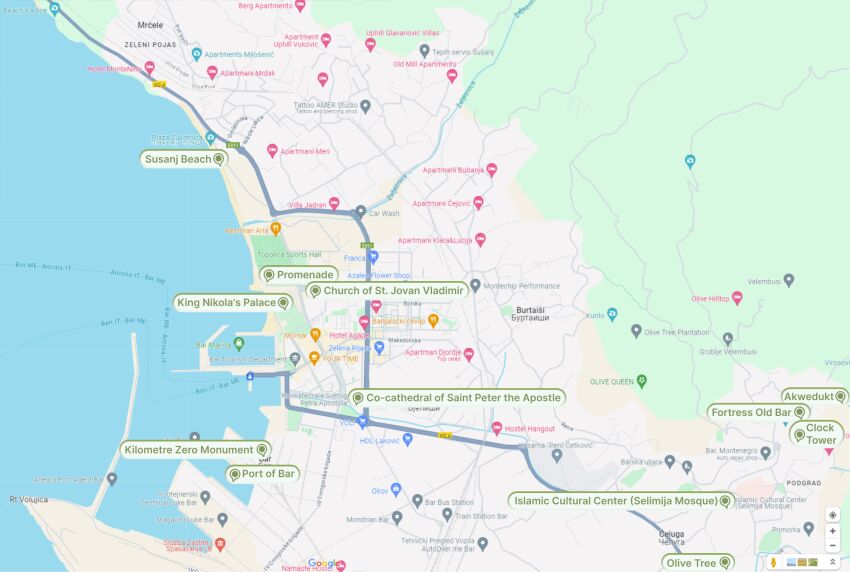
Conclusion
Bar has a length of several kilometers along the sea. Within the municipality, there are spacious beaches, an ancient fortress, iconic structures representing all major religions, a port complex, palaces, and a vast urban promenade. We recommend starting your journey and sightseeing in the Old City. In the morning, the sun will be at your back, and the views towards the sea from the Citadel will be captivating and unobscured by the southern sun. Moreover, in the suburbs of this area, you'll find plenty of cafes and restaurants where you can try Montenegrin and Bulgarian national dishes.
Right next to the entrance to the fortress lies a cozy and colorful trading street, Carsija, with Turkish delight and Turkish coffee on every corner. With your first steps along its path, you'll feel the scent of Eastern culture, immersing yourself in a world of caravan routes and minarets.
After lunch, you can head towards New City, stroll along its waterfronts, visit numerous shops, and the huge shopping center built back in Yugoslav times. In the New District, there is a small ethnographic museum located in the Palace of the former king of Montenegro, Nikola.
From the city promenade, walk to the waterfront, where in the evening you can witness magnificent sunsets. Pause at one of the cafes right by the sea, breathe in the sea air, and listen to the horns of ships entering the port. The sea sends its greetings, it's right there, nearby.
About the Author
Nikolai Stepanov is a licensed guide in Montenegro and a historian. He has been living in the country for over 10 years. He conducts his own tours of Montenegro with a historical-analytical focus, striving to make his excursions engaging and not tedious.
He is published and quoted in Serbian and Montenegrin press, gaining friends among the local academic elite. His work appears in Serbia's oldest and most influential newspaper, "Politika", the Russian portal about Montenegro"OpenMonte", and the newspapers"Vesti"and"Sloboda Reč". In his research, he exclusively uses local archival and scholarly sources.

